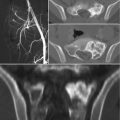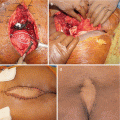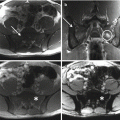© Springer International Publishing AG 2017
Pietro Ruggieri, Andrea Angelini, Daniel Vanel and Piero Picci (eds.)Tumors of the Sacrum10.1007/978-3-319-51202-0_2828. Tumors of the Sacrum: The Role of Chemotherapy
(1)
Department of Chemotherapy, Istituto Ortopedico Rizzoli, Bologna, Italy
28.1 Introduction
The use of chemotherapy has changed the natural history of sarcomas, and as most of the lesions arising in the sacrum are primary bone sarcomas, they can benefit from systemic treatment with antineoplastic agents.
Osteosarcoma, Ewing sarcoma, and the group of undifferentiated high-grade pleomorphic bone sarcomas are the tumors where the effectiveness of chemotherapy is most apparent. In the most recent years, also for tumors previously considered refractory to systemic chemotherapy such as giant-cell tumors, chondrosarcomas, and chordoma, new medical treatments are now available.
In the absence of evidence regarding a possible relation between chemosensitivity and skeletal location of the tumors, systemic treatment of sacral tumors follows the same criteria used for the treatment of primary bone sarcomas with other skeletal locations. As stated in the other chapters, the main challenge posed by sacral tumors is local treatment. Chemotherapy, apart from the effect against micrometastatic diseases, may also contribute to improve local control.
The different entities that can be diagnosed in the sacrum require specific systemic treatments comprising classic antineoplastic agents and more recent treatments with targeted therapies.
In this chapter, the role of chemotherapy will be described focusing on the main primary bone sarcomas.
28.2 Osteosarcoma
Osteosarcoma, together with Ewing sarcoma, is the first primary bone tumor where chemotherapy displayed its effectiveness in the early 1970s [1]. When patients received only surgery, survival rate was lower than 20% [1]. Today, it is widely accepted that the treatment of osteosarcoma requires a combined approach of surgery of the primary tumor and systemic chemotherapy with an expected probability of survival, in case of localized disease and extremity tumors, of around 75% [2]. Standard strategy of chemotherapy for osteosarcoma is based on primary chemotherapy, delayed surgery followed by adjuvant chemotherapy (neoadjuvant chemotherapy) [2].
Thanks to its preoperative use, it is possible to evaluate chemotherapy-induced tumor necrosis by histological examination of the resected surgical specimen [3]. The extent of tumor necrosis is a surrogate marker of chemosensitivity and is predictive of survival [4, 5]. Imaging techniques such as PET and dynamic magnetic resonance have been used to evaluate the pathological response to primary chemotherapy, but their significance is still under discussion [2].
New insights are coming from studies of pharmacogenetics in osteosarcoma. Germline genetic polymorphisms predictive of sensitivity to chemotherapy have been recently described [6–8]. Microarray technology has been recently investigated to predict chemotherapy response and a multigene predictive model was developed to classify good and poor responders to preoperative chemotherapy [8].
Most chemotherapy regimens adopted for osteogenic sarcoma are based on methotrexate (MTX), cisplatin (CDP), doxorubicin, and ifosfamide (IFO). It is well-known that when only CDP and adriamycin (ADM) are used, a probability of disease-free survival (DFS) around 45% can be expected [9].
Strategies of chemotherapy based on the use of the four active drugs lead to a probability of DFS around 60–65% [9]. It is a matter of discussion whether all patients require intensive and prolonged treatment based on all four active drugs [10, 11].
In a recent study, the Italian Sarcoma Group (ISG) demonstrated that IFO can be given postoperatively and only to patients with a poor pathological response to primary chemotherapy based on MTX, CDP, and ADM [12]. This approach allowed the same results with lower toxicity than a chemotherapy based on the four drugs delivered since the primary phase in all patients. A study of the Children’s Cancer Group and Pediatric Oncology Group has evaluated whether the addition of ifosfamide and/or muramyl tripeptide-phosphatidylethanolamine (MTP-PE) to methotrexate, cisplatin, and doxorubicin could improve prognosis [13]. MTP-PE is a component of the bacterial cell wall conjugated to phosphatidylethanolamine and encapsulated in liposomes with immunostimulating activity. Overall, the probability of survival was higher in those patients treated with MTP-PE and a trend was reported in terms of event-free survival (EFS) [14]. Based on these data, EMA licensed the drug for commercial use in Europe.
The possible role of immunotherapy in osteosarcoma patients was investigated in a large randomized trial. EURAMOS 1 study [15] randomized patients with good pathological response to the MAP regimen to receive maintenance treatment with interferon. Unfortunately, the results recently reported did not show advantages for patients assigned to the interferon arm [15]. In the same study, the use of a differentiated and intensified treatment in patients with a poor pathological response to MAP failed to show an advantage in survival.
These data are sufficiently robust to support the MAP regimen as the standard treatment in patients with osteosarcoma.
28.3 Ewing Sarcoma
Ewing sarcoma (ES) shares with osteosarcoma similarities in the strategy of treatment.
Neoadjuvant chemotherapy with the aim of reducing tumor mass, increasing the likelihood of local control, and facilitating conservative surgical approaches is considered the standard in patients with Ewing sarcoma [16].
Vincristine, dactinomycin, adriamycin, cyclophosphamide, ifosfmide, and etoposide are the drugs that, in different combinations, are recommended for the neoadjuvant treatment of Ewing sarcoma [16].
Contrary to osteosarcoma, local control in ES can be achieved by surgery or radiotherapy, this tumor being highly sensitive to this last technique. Nevertheless, there is a body of evidence on the superiority of surgery versus radiotherapy in terms of local control rate and late effects. For this reason, the surgical treatment of patients with ES is now preferred and recommended whenever possible [2, 16].
As in osteosarcoma, when ES is surgically treated, the pathological evaluation of chemotherapy-induced tumor necrosis can identify patients having a different probability of survival [2, 16]. Previous studies reported a probability of EFS ranging from 63 to 81% in case of good response and ranging from 20 to 38% in case of poor response [17–19].
In the light of the predictive significance of chemotherapy-induced tumor necrosis, imaging techniques such as PET and dynamic magnetic resonance have been investigated in order to predict tumor response to primary chemotherapy. The results of these studies, most of them being retrospective, are at present not conclusive [20–23].
There is no agreement in the sarcoma community about the best strategy of chemotherapy in patients with Ewing sarcoma. Several data indicate that dose intensification is beneficial [1].
In a joint study carried out by Italian Sarcoma Group and Scandinavian Sarcoma Group, a dose-intensified treatment with high-dose busulfan and melphalan followed by peripheral blood stem cell rescue was used in patients with poor response to primary chemotherapy comprising vincristine, dactinomycin, adriamycin, cyclophosphamide, ifosfmide, and etoposide. The results showed that poor responder patients had the same probability of event-free survival as good responder patients [24]. The use of high-dose chemotherapy in patients with ES is still a matter of debate [1]. A study protocol [25] was activated some years ago to investigate the role of high-dose chemotherapy in ES. Interesting results, superior to those reported in literature, were obtained in the group of the so-called very high-risk patients (patients with multivisceral metastases with or without bone marrow infiltration) who could receive high-dose chemotherapy [26]. In the same study, patients with poor response to primary chemotherapy or with lung metastases only were randomized to receive intensified treatment with high-dose chemotherapy or a postlocal treatment regimen with chemotherapy at standard dose. Unfortunately, the results of this group of patients are not yet available.
A different way to dose intensification was that followed by the Children Oncology Group. In a randomized study [27], standard chemotherapy courses were delivered every 3 or 2 weeks with the support of G-CSFs. All patients received the same treatment regardless of the response to primary chemotherapy. Overall, the results of the study were comparable to those obtained in protocols with high-dose chemotherapy in poor responder patients. Interestingly, results of the study demonstrated that dose intensification obtained by an interval compression (every 2 weeks) is more effective than a standard approach based on chemotherapy courses given every 3 weeks. The study population consisted mainly of children and adolescents and only 15% of patients were older than 18 years and this makes the sample not entirely representative of the real population of patients with ES. Furthermore, the survival advantage was apparent in young and not in adult patients. Nevertheless, these data are an important contribution to the clinical practice suggesting that an interval compression of chemotherapy courses should be recommended at least in younger patients.
28.4 Chondrosarcoma
Chondrosarcoma is, after osteosarcoma, the second most common primary bone tumor. Chondrosarcomas are a diverse group of tumors that share the characteristic of chondroid matrix production, but show different histology, biological behavior, and chemosensitivity [28].
Conventional chondrosarcoma, the most frequent type of chondrosarcoma, is a slow-growing tumor whose aggressiveness and tendency to metastasize is strictly correlated to the grade of the tumor. There is wide agreement that it is resistant to the antineoplastic agents used for bone sarcomas. Surgery, whenever possible, is the main treatment. Grade 3 and, less frequently, grade 2 chondrosarcoma can give metastases, especially to the lungs, and also in this case surgery is the recommended approach. Nevertheless, there are clinical situations of unresectability where the use of chemotherapy is part of the clinical practice. A recent retrospective study reported that overall survival for patients with unresectable diseases is poor, with a 3-year overall survival (OS) of 12% (5-year survival of 2%). Patients with only local unresectable disease had a better prognosis than those with metastatic disease, with an overall survival of 26% after 3 years [29]. It is interesting to note that when the treatment received was analyzed, the authors found a survival benefit for metastatic patients who underwent chemotherapy. The efficacy of systemic treatment was apparent only in patients with metastatic disease and not in patients with locally advanced unresectable chondrosarcoma. As stated by the authors, “the general result of improved survival after chemotherapy is rather unexpected because the common opinion is that chondrosarcoma patients do not benefit from nonsurgical treatment.” These data, although coming from a retrospective analysis, support the use of chemotherapy also in chondrosarcoma in the presence of unresectable metastatic disease. No data supporting a specific chemotherapy regimen can be suggested, doxorubicin, ifosfamide, and cisplatin being the most frequently used antineoplastic agents. Recently, a long-lasting response to gemcitabine has been reported in a patient with metastatic chondrosarcoma [30].
Several attempts have been made to explore alternative targets in chondrosarcomas. Based on the evidence that the platelet-derived growth factor receptor (PDGFR) is expressed and phosphorylated, a clinical study with imatinib was carried out, but failed to demonstrate any activity [31]. Some interest was posed on the evidence of the expression of aromatase and estrogen receptors in chondrosarcoma, but the use of drugs inhibiting estrogen signaling was not found beneficial [32]. Preclinical data have shown that the Hedgehog pathway plays an important role in tumor proliferation of chondrosarcoma [33] and a phase 2 study (ClinicalTrials.gov Identifier: NCT01310816) with the smoothened inhibitor IPI-926 has been recently carried out, but the results are at present not available.
Rare variants of chondrosarcoma are mesenchymal chondrosarcoma, dedifferentiated chondrosarcoma, and clear cell chondrosarcoma.
Mesenchymal chondrosarcoma arises in patients of younger age compared to conventional chondrosarcoma; it is characterized by a bimorphic histological pattern in which a relatively well-differentiated cartilage tissue is admixed with a highly undifferentiated small cell component [28]. Small cells can appear to be round, oval, or spindle-shaped, and this component often resembles a hemangiopericytoma or Ewing sarcoma. There is a tendency to metastasize. On the contrary to what reported for conventional chondrosarcoma, some retrospective studies have shown a superior survival for those patients who received chemotherapy [34–36]. On the basis of what has been reported in literature, it is not possible to identify a standard chemotherapy treatment; nevertheless, it is interesting to note that most patients were given a chemotherapy regimen including antineoplastic agents commonly used for Ewing sarcoma.
Dedifferentiated chondrosarcoma is characterized by the presence of a high-grade component with histologic features of classic osteosarcoma or high-grade undifferentiated pleomorphic sarcoma [28]. The clinical behavior of this rare variant is that of an aggressive sarcoma with a very high rate of metastases. The probability of survival in this group of patients is very low, but patients can benefit from chemotherapy [35]. The largest retrospective study reporting data on the role of systemic chemotherapy in dedifferentiated chondrosarcoma shows a survival advantage in patients without metastases at presentation [37]. Most chemotherapy regimens employed are based on drugs commonly used in osteosarcoma with dose and schedule age adapted, since dedifferentiated chondrosarcoma is more frequent in adult and elderly patients. A prospective study exploring the role of an osteosarcoma-like chemotherapy protocol in patients with dedifferentiated chondrosarcoma has been recently closed to enrollment and the final results will be published in the next year [38].
28.5 Giant-Cell Tumor of Bone
Giant-cell tumor of bone (GCTB) is a rare, osteolytic tumor that mainly occurs in young adults. GCTB is locally aggressive and metastases (mostly to the lung) can occur in up to 6% of patients. The majority of patients can be adequately treated by surgery, but in some, due to site and/or size of the tumor, surgery is not feasible. In case of unresectable GCTB, several options are part of the clinical practice, radiotherapy, and embolization over all, but the results are usually poor and they have a meaning of palliation and not a curative intent. Interferons, bisphosphonates, classic chemotherapy have been tried with unsatisfactory results [39].
Stay updated, free articles. Join our Telegram channel

Full access? Get Clinical Tree






